|
Displaying items by tag: architect

The Milwaukee Art Museum has announced its Plan for the Future, a comprehensive public campaign to restore its War Memorial Center and Kahler building and reinstall the galleries. The Milwaukee Art Museum is comprised of three buildings designed by three legendary architects -- the War Memorial Center, a masterpiece of mid-twentieth-century design created by Finnish architect Eero Saarinen in 1957; the Kahler building, which was created by the American architect David Kahler in 1975 to create additional exhibition space; and the Quadracci Pavilion, which was created in 2001 by the Spanish architect Santiago Calatrava.
Last spring, Milwaukee County donated $10 million to help fund the repair of the museum’s War Memorial Center and Kahler building, which house the institution’s Collection galleries. The museum hopes to raise another $15 million to fund additional renovations and a reinstallation of the collections. The institution will be asking for public donations as part of its Plan for the Future campaign, which took two years to develop.
The overarching goals of the Plan for the Future are to increase exhibition space; create a new lakeside entrance, establishing easier public access to the museum; reinstall the collection with a more intuitive layout; and install energy-efficient LED lighting. Repairs and restorations to the Milwaukee Art Museum are slated to begin in the fall. The museum will remain open during the project.

The Crystal Bridges Museum of American Art in Bentonville, AK has acquired Frank Lloyd Wright’s Bachman Wilson House in Millstone, NJ from architect/designer team Lawrence and Sharon Tarantino. Built along the Millstone River, the house has suffered significant flood damage and relocation has been recommended in order to preserve the structure. The Tarantinos held a multi-year search to find a buyer that could provide an appropriate setting and context for the historic building. The house will be disassembled and relocated to Bentonville, where it will be re-assembled on Crystal Bridges’ 120-acre campus.
The Bachman Wilson house was commissioned in 1954 by Abraham Wilson and Gloria Bachman, whose brother, Marvin Bachman, was an apprentice in the Frank Lloyd Wright Taliesin Fellowship. The structure reflects Wright’s Usonian period, which was defined by simplicity and practicality. Crystal Bridges plans to incorporate the house into its educational and public program offerings. In addition, thanks to an ongoing partnership with the University of Arkansas, the museum anticipates making Wright’s house available to the University’s Fay Jones School of Architecture.
Site preparation at Crystal Bridges for the Bachman Wilson House will begin this spring. The museum plans to have the project completed in early 2015.
Art, photography, and furniture dealer, Daniel Wolf, and Maya Lin, his award-winning architect wife, are planning to purchase the Yonkers City Jail for $1 million. The couple will turn the rundown, 10,000-square-foot structure into studio, gallery and loft space. The former jail closed in September and was put on the market by the city for $2.5 million.
The space, which will be designed by Lin, will house Wolf’s collection and serve as a base for dealing art as well as holding exhibitions and other public events. Yonkers’ Mayor, Mike Spano, said, “This prime waterfront real estate in the heart of our vibrant downtown area was no place for a jail, but it’s an ideal location for an international art collection like that of Daniel Wolf.”
A closing is expected in December when the city approves the transaction.
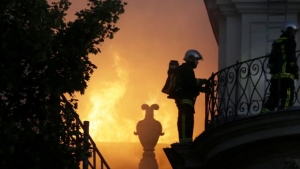
A fire broke out at an historic 17th century mansion in Paris on Wednesday, July 10, 2013, destroying artworks dating back hundred of years. The mansion, known as Hotel Lambert, was acquired by the Qatari royal family in 2007 and was in the midst of controversial renovations when the blaze took place. The fire devastated murals, paintings and frescoes by French luminaries such as Charles Le Brun (1619-1690).
The architect Louis Vau designed Hotel Lambert, which overlooks the Seine, in the 1640s for the wealthy financier, Nicolas Lambert. The mansion is considered one of the finest examples of mid-17th-century French architecture, boasting frescoes by Le Brun and other masters of the day including Eustache Le Sueur (1617-1655). In addition to its impressive interior, the Hotel Lambert was home to many powerful figures over the centuries including the philosopher, Voltaire. When the Qatari royal family purchased the mansion, critics feared that one of France’s historic gems would be destroyed, especially after the family revealed plans to renovate the estate.
Dozens of firefighters battled the blaze at the UNESCO-designated mansion for nearly six hours. The cause of the fire has not been determined and is still under investigation by police.
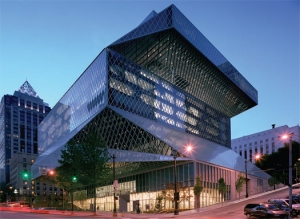
Officials at the State Hermitage Museum in St. Petersburg, Russia announced that the Dutch architect Rem Koolhaas will design a freestanding addition to the institution’s existing structure. Founded by Catherine the Great in 1764, the Hermitage is one of the largest and oldest museums in the world.
Koolhaas, a Pritzker Prize winner, has designed Portugal’s Casa de Música, the Seattle Central Library and Kunsthal Rotterdam in the Netherlands. He has worked with the Hermitage for over a decade and designed the fleeting Hermitage Guggenheim in Las Vegas in the early 2000s. Koolhaas has been working with the Hermitage’s director, Mikhail Piotrovsky, since 2008 on a rearrangement of the museum’s existing interior. That project is expected to conclude in 2014 and will coincide with the museum’s 250th anniversary.
The Hermitage’s new building will be located outside of St. Petersburg’s historic center. Contemporary architecture is banned from the area so to preserve the unity of the city’s aesthetic. The Koolhaas-designed structure will include a library, costume museum, a publishing house and various public spaces.

A major step has been taken in the Menil Collection’s master plan to create a “neighborhood of art” on their 30-acre campus. The Houston museum has chosen landscape architect Michael Van Valkenburgh to helm the expansion, which consists of the construction of six buildings dedicated to art, an outdoor sculpture park, bungalows, and green spaces spread across several blocks. Van Valkenburgh, who has offices in Brooklyn, NY and Cambridge, MA, has redesigned Pennsylvania Avenue at the White House (Washington, D.C.), Brooklyn Bridge Park (New York), Hudson River Park (New York), and the Isabella Stewart Gardner Museum (Boston). The London-based firm David Chipperfield Architects is directing the Menil’s overarching expansion plan, which includes the creation of new green spaces, walkways, visitor amenities, and gallery buildings.
Renzo Piano designed the Menil, which was founded by collectors John and Dominique de Menil, in 1987. The museum houses the de Menil’s comprehensive collection of 20th century art, which includes works by René Magritte (1898-1967), Man Ray (1890-1976), Henri Matisse (1869-1954), Jackson Pollock (1912-1956), Pablo Picasso (1881-1973), and Mark Rothko (1903-1970). The museum also includes a separate gallery dedicated to Cy Twombly (1928-2011), which was also designed by Piano.
The first phase of the renovation is expected to kick off in September 2013.
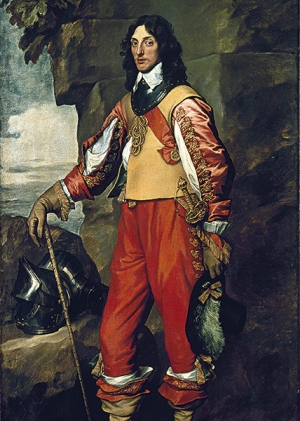
A selection of oil paintings from Russia’s Hermitage Museum will be on view at Houghton Hall in England from May 17, 2013 through September 29, 2013. Great Britain’s first prime minister, Sir Robert Walpole, assembled the collection during the first half of the 18th century and built Houghton Hall to house the works. Paintings from Russian and American collections will complement the works, which are returning to England for the first time in 230 years.
Walpole built Houghton Hall, which now belongs to Lord Cholmondeley, one of his direct descendants, between 1722 and 1735. In 1779,When Walpole’s grandson was in need of money, he sold the majority of his grandfather’s collection to Catherine the Great for nearly $61,500. Approximately 75 of the sold works are returning to Houghton Hall for the exhibition including paintings by Rembrandt (1606-1669), Anthony van Dyck (1599-1641), Nicolas Poussin (1594-1665), and Diego Velázquez (1599-1660).
While a handful of the paintings have been on view in England since their sale in the 18th century, none of them have returned to Houghton Hall. Designed by the foremost architects of Walpole’s time, James Gibbs and Colen Campbell, Houghton Hall’s lavish interior was decorated by the eminent architect and furniture designer William Kent. Walpole spared no expense and Houghton Hall remains as one of the finest examples of Palladian architecture in England.

The Kimbell Art Museum in Fort Worth, Texas announced on Friday, May 3, 2013 that they will open their new Renzo Piano-designed building on November 27, 2013. The structure, which cost $135 million to build, includes a parking garage, auditorium, galleries, offices, and an education wing. Renovations have been underway since 2010 and are expected to reach completion on schedule. However, The project did run over its original budget by $10 million.
Famed architect Louis Kahn designed the Kimbell’s original building in 1972. Piano, who was once Kahn’s assistant, designed the new structure so that it would be similar in size and made out of comparable materials as the older, accompanying building. Stretching 22 feet high, the new structure will include environmentally friendly features and will consume half of the energy needed to operate Kahn’s building.
The Kimbell’s collection, which ranges from international antiquities to contemporary art, will be split between the two buildings. The Kahn building will house the European works and the Pre-Columbian, African, and Asian art will be exhibited in the Piano pavilion.
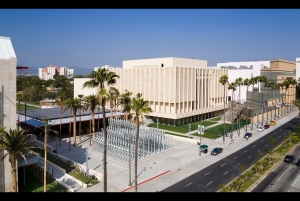
On Wednesday, May 1, 2013 the Los Angeles County Museum of Art announced that they will publicly unveil plans for a new building next month. The institution has picked Pritzker Prize-winning architect Peter Zumthor to design LACMA’s new home.
The project is expected to cost $650 million and will include the demolition of the original LACMA building, which was built in 1965, as well as an addition that was constructed in 1986. Dutch architect Rem Koolhaas proposed a similar plan in 2001 but fundraising problems prompted the museum to cancel the project. Michael Govan, the current director of LACMA, has been ramping up fundraising efforts since he joined the museum in 2006 and has succeeded in expanding donor funding and enlarging the museum’s board.
Under Govan’s direction, LACMA had opened two buildings designed by Renzo Piano, the Broad Contemporary Art Museum, and the Resnick Pavilion. Zumthor’s plans leave the newer buildings untouched as well as the Pavilion for Japanese Art, which opened in 1988.
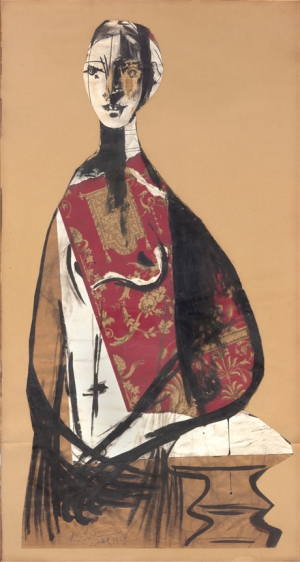
The Louvre’s new outpost in Abu Dhabi, which is slated to open in 2015, has assembled the 130 paintings, miniatures, sculptures, and other artworks that will form its permanent collection. Museum officials allowed reporters a sneak peek of the works including paintings by Pablo Picasso (1881-1973), Rene Magritte (1898-1967), Édouard Manet (1832-1883), and Paul Gauguin (1848-1903). The entire collection will be on view from April 22 to July 20, 2013 as part of the exhibition The Birth of a Museum at a gallery on the island of Saadiyat, close to where construction for the new museum is currently underway.
Louvre Abu Dhabi’s collection is comprised of numerous works from private collections, many of which have never been on public view before. Highlights from the museum’s holdings include Picasso’s gouache, ink, and collage work on paper Portrait of a Lady (1928); Gauguin’s Children Wrestling (1888); and Paul Klee’s (1879-1940) Oriental Bliss (1938).
The Louvre’s new venue, which was designed by the French architect Jean Nouvel, is the museum’s first branch outside of France. The venture is expected to bring the Louvre and its French partner museums approximately $1.31 million over 30 years. The Louvre also has an offshoot location in the northern city of Lens.
|
|
|
|
|